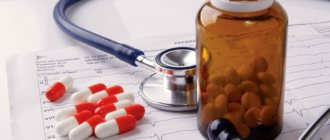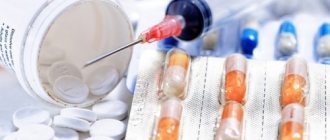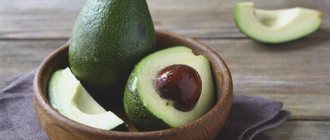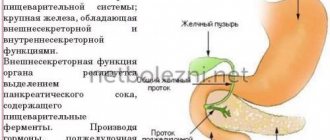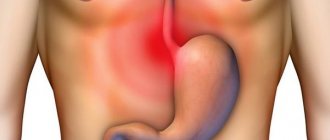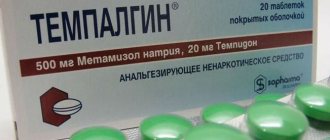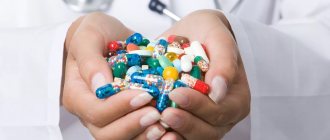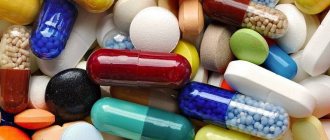Pain in the upper abdomen is the main symptom of a stomach ulcer. Most often it occurs 4-5 hours after eating or at night. To get rid of pain, it is necessary to treat the disease and prevent its aggravation. But what if the pain occurs suddenly? What painkillers can you take for a stomach ulcer?
To relieve pain from peptic ulcers, drugs of the main 5 groups can be used:
- Antispasmodics.
- Anticholinergics.
- Ganglioblockers.
- Antacids.
- Bismuth preparations.
In addition to them, noticeable relief occurs when taking proton pump blockers and H2-histamine receptor blockers.
Causes, signs and symptoms, how to treat stomach ulcers?
A gastric ulcer is a chronic disease in which trophic disorders occur in the gastric mucosa. Most often, ulcers occur in men aged 20 to 50 years.
The disease is characterized by frequent relapses in spring and autumn. The cause of stomach ulcers, as a rule, is frequent stress, which strains the human nervous system, which, in turn, causes spasms of the muscles and blood vessels of the gastrointestinal tract. As a result, the blood supply to the stomach is disrupted, and gastric juice begins to have a detrimental effect on the mucous membrane, which leads to the formation of ulcers.
But still, the main cause of stomach ulcers is the bacterium Helicobacter pylori and an imbalance between the protective mechanisms of the stomach and aggressive factors, that is, the mucus that the stomach secretes cannot cope with pepsin, the enzyme responsible for digesting proteins, and hydrochloric acid. Recently, there has been a tendency towards an increase in the incidence of the disease among women. The incidence of the disease depends not only on age and gender, but also on the professional activity of the person.
Thus, those people whose work is associated with the risk of abdominal injury, for example, shoemakers, and those who do not have the opportunity to regularly consume liquid food, for example, railway workers, suffer more often. In addition, stomach ulcers occur with different frequencies in different regions of the same country, which is determined by the dietary habits of local residents.
Knowing the main symptoms of a developing pathological process will allow you to quickly consult a doctor for help and diagnose the disease, which guarantees the success of therapeutic intervention without surgical intervention. However, sometimes a stomach ulcer does not manifest itself at all, which indicates the need for regular examination.
Pain sensations localized in the upper abdomen. It is expressed in a burning sensation in the epigastric region. It occurs due to the fact that the acidic contents of the stomach, which has an aggressive environment, enters the lumen of the esophagus, irritating its walls.
Heartburn usually appears an hour after eating. Feeling of nausea, sometimes accompanied by vomiting. This symptom occurs due to impaired gastric motility. With an ulcer, vomiting occurs 1 hour after eating and, as the stomach is emptied, brings a feeling of relief. Therefore, patients often induce vomiting on their own; Decreased appetite during peptic ulcer disease may be associated with a person’s fear of experiencing pain or with disturbances in gastrointestinal motility;
Belching, which is characterized by the uncontrolled reflux of gastric juice into the oral cavity. In this case, the patient feels bitterness or a sour taste in the mouth; The appearance of a feeling of heaviness in the abdominal area, observed after eating; Stool disorders. Most often, patients complain of constipation, and diarrhea is not typical for peptic ulcer disease. Among the external signs of a stomach ulcer, it is especially worth noting the presence of a gray coating on the tongue, which almost always indicates problems with the gastrointestinal tract. The patient may suffer from increased sweating of the palms and experience pain when pressing on the epigastric region.
Depending on the complaints made by patients, the doctor is able to suspect an ulcer of one or another part of the stomach: When the subcardial and cardiac sections are affected, the feeling of pain begins to bother you early, about 20 minutes after eating.
In this case, unpleasant sensations are localized quite high - at the very xiphoid process of the epigastric region. Often such pain can radiate to the heart and be incorrectly differentiated. Their clear relationship with food intake can be traced, but there are no parallels with physical activity. Relief comes from drinking milk or antacids. As for intensity, the pain is mild.
They are often accompanied by vomiting, belching, and heartburn. When the lesser curvature of the stomach is affected, pain occurs in the epigastric region, which is located to the left of the midline of the abdomen. Their start time after eating is on average 1 hour. After the stomach copes with its task, the pain goes away. Patients often complain of discomfort after long breaks in food, as well as in the evening and night hours.
The intensity of the pain is moderate, the nature is aching. When the process worsens, the pain becomes very pronounced. The patient often feels nauseous, but rarely vomits; When the greater curvature of the stomach is affected, the pain is of low intensity, which makes it difficult to diagnose this type of ulcerative lesion. Moreover, it is precisely this ulcer that is often malignant in nature, although it is rare;
When the antrum is affected, pain often occurs in the evening and at night, accompanied by sour belching and heartburn. Localization - epigastric region; When the pyloric canal is damaged, the pain is quite intense, its character is paroxysmal. One attack can last up to 40 minutes. There are pains at night and when hungry, but in some patients there is no connection between food intake and pain. Saliva production increases, and persistent and prolonged heartburn often occurs. Sometimes doctors encounter atypical manifestations of the ulcerative process.
In this case, pain may occur in the right hypochondrium, in the right iliac region, in the lumbar region, in the heart region, or not appear at all. All this makes diagnosing the disease difficult and often leads to complications.
This is a spiral-shaped bacterium that adapts to the aggressive environment of the stomach and has the ability to neutralize hydrochloric acid. Under the influence of the waste products of this bacterium, the cells of the gastric mucosa die, which leads to the development of ulcers.
It is not difficult to become infected with this bacterium, the source is the carrier, and it is transmitted through saliva during a kiss, through contaminated food and water, through undisinfected medical instruments, through dirty dishes, from mother to fetus. Taking medications. First of all, the development of the disease is influenced by NSAIDs aspirin, indomethacin, diclofenac, butadione, ketoprofen, ibuprofen. The risk increases when the patient's age exceeds 65 years, as well as if there have been documented cases of gastric bleeding, if large doses of medication are required, if treatment is accompanied by the use of anticoagulants or glucocorticoids.
Other medications that can trigger the development of ulcers include cytostatics, potassium supplements and antihypertensive drugs; An ulcer can result from other diseases, including tuberculosis, diabetes mellitus, Crohn's disease, hyperparathyroidism, lung cancer, hepatitis, liver cirrhosis, pancreatitis, syphilis and others;
Stomach injuries, blood poisoning, any shock conditions, burns of a large surface of the body and frostbite;. Stress, poor nutrition, bad habits, unstable emotional state.
In particular, coffee abuse can be attributed to factors influencing the development of ulcers; Hereditary factor, in particular, the presence of a similar pathological process in close relatives. Risk factors There are many factors leading to the development of ulcers, but here are those that are considered to be the most common:. Frequent and large doses of soda and drinks containing caffeine;
Eating food that is too cold or too hot, which can damage the stomach lining; Frequent depression or stressful situations;. Frequent and excessive consumption of rich foods such as buns and cakes. Stomach ulcers can cause serious complications, many of which can be fatal. In this case, the gastric wall is destroyed, and the organ located directly under this wall becomes the bottom of the ulcer.
Most often, the pancreas is affected, but sometimes the process affects the lesser omentum, gall bladder, intestines or liver. The hydrochloric acid secreted by the stomach destroys the pancreas and leads to the development of acute destructive pancreatitis.
The fact that the patient has manifested penetration is evidenced by acute girdling pain, an increase in body temperature to critical values and an increase in the level of alpha-amylase in the blood. All signs of inflammation are present, pain occurs regularly, regardless of food intake or time of year. To establish the presence of penetration, it is necessary to conduct an X-ray examination of the stomach and FGS;
Perforation of the stomach, when, as a result of the destruction of one of its walls, the contents spill into the abdominal cavity.
The impetus for perforation of the wall can be increased physical activity, consumption of spicy food, and alcohol. In this case, the patient complains of severe pain in the abdomen, a feeling of general weakness, and there are signs of poisoning of the body.
A perforation that occurs suddenly can lead to painful shock; after 10 hours the person develops peritonitis. In this case, FGS is contraindicated; an x-ray of the stomach is required;
Stomach bleeding. Often accompanied by penetration. In this case, the patient vomits, the masses look like coffee grounds, and general signs of blood loss are observed. The stool becomes black and tarry. The pressure drops, shortness of breath, tachycardia occurs, and sweating appears.
It is important to stop bleeding in a timely manner, otherwise it will lead to death. As for duodenal ulcers, they never turn into cancerous tumors. In most cases, callous ulcers and those that scar for a long time are susceptible to degeneration. If the ulcer transforms, the patient rapidly loses weight and refuses to eat, especially meat.
As the tumor process progresses, the person begins to suffer from fever and vomits, often with blood. Without seeking medical help, the body will be brought to a state of complete exhaustion, which can lead to death. If transformation of the ulcer is suspected, timely FGS is necessary with a three-point biopsy taking material from the walls of the ulcer, from its bottom and edges;.
Pyloric stenosis is a dangerous complication of an ulcer localized in the pyloric part of the organ, that is, in the narrowest part of the stomach. The more often the ulcer recurs, the higher the risk of this complication. The narrowing of the pylorus leads to the fact that food begins to stagnate in the organ due to difficulties in passing into the intestines. Compensated stage, during which symptoms such as sour belching, a feeling of heaviness and fullness of the stomach are observed.
However, the patient feels satisfactory;
Drugs that lower blood cholesterol: a review of drugs
A headache can cause a lot of inconvenience and disturb your usual rhythm. To quickly get rid of painful discomfort, modern medicine offers a wide selection of analgesics, which differ in the degree of action and indications for use.
Often the medicinal name is used by several manufacturers, but the effect of taking the drug is not always the same. Some pharmaceutical companies produce a more effective medicine, others less, although the active ingredients are the same (the cost may also differ, depending on the manufacturer).
The secret lies in compliance with production technologies, the availability of clinical trials, the quality of purification of chemicals from impurities and other factors.
6. GlaxoWellcome Production
Have you been struggling with HYPERTENSION for many years without success?
Head of the Institute: “You will be amazed at how easy it is to cure hypertension by taking it every day.
Drug therapy for lipid metabolism disorders is prescribed if a lipid-lowering diet, rational physical activity and weight loss are ineffective for 6 months.
To correct lipid metabolism, antiatherogenic (hypolipidemic) agents are prescribed. The purpose of their use is to reduce the level of “bad” cholesterol (total cholesterol, triglycerides, very low lipoproteins (VLDL) and low density lipoproteins (LDL)), which slows down the development of vascular atherosclerosis and reduces the risk of developing its clinical manifestations: angina pectoris, heart attack, stroke and others diseases.
Our readers successfully use ReCardio to treat hypertension. Seeing how popular this product is, we decided to bring it to your attention. Read more here...
Classification
- Anion exchange resins and drugs that reduce the absorption (assimilation) of cholesterol in the intestine.
- A nicotinic acid.
- Probucol.
- Fibrates.
- Statins (inhibitors of the enzyme 3-hydroxymethyl-glutaryl-coenzyme-A reductase).
Depending on the mechanism of action, drugs for lowering blood cholesterol can be divided into several groups.
Drugs that prevent the synthesis of atherogenic lipoproteins (“bad cholesterol”):
- statins;
- fibrates;
- a nicotinic acid;
- probucol;
- benzaflavine.
Drugs that slow down the absorption of cholesterol from food in the intestine:
- bile acid sequestrants;
- Guarem.
Medicines that bind bile acids (cholestyramine, colestipol) are classified as anion exchange resins. Once in the intestines, they “capture” bile acids and remove them from the body.
The body begins to experience a lack of bile acids necessary for normal functioning. Therefore, the process of their synthesis from cholesterol starts in the liver.
Cholestyramine and colestipol are available in powder form. The daily dose should be divided into 2–4 doses and consumed by diluting the drug in liquid (water, juice).
Anion exchange resins are not absorbed into the blood, acting only in the intestinal lumen. Therefore, they are quite safe and do not cause serious unwanted effects.
Side effects include bloating, nausea and constipation, and less commonly, loose stools. To prevent such symptoms, it is necessary to increase the intake of fluid and dietary fiber (fiber, bran).
With long-term use of these drugs in high doses, the absorption of folic acid and some vitamins, mainly fat-soluble, in the intestine may be impaired.
Bile acid sequestrants reduce cholesterol levels. The triglyceride content does not change or even increases.
MORE ABOUT: Stomach cancer - causes, signs, symptoms and treatment of stage 4 stomach cancer. Surgery and chemotherapy
If the patient has an initially elevated level of triglycerides, anion exchange resins must be combined with drugs from other groups that reduce the level of this fraction of blood lipids.
By slowing down the absorption of cholesterol from food in the intestines, these drugs reduce its concentration in the blood. The most effective of this group of remedies is guar.
It is a herbal dietary supplement obtained from the seeds of hyacinth beans. It contains a water-soluble polysaccharide, which forms a kind of jelly upon contact with liquid in the intestinal lumen.
Guarem mechanically removes cholesterol molecules from the intestinal walls. It accelerates the excretion of bile acids, leading to increased uptake of cholesterol from the blood into the liver for their synthesis.
https://www.youtube.com/watch?v=w8JtPRD-TDM
The drug suppresses appetite and reduces the amount of food eaten, which leads to a decrease in weight and blood lipids. Guarem is available in granules, which should be added to liquid (water, juice, milk).
Side effects include bloating, nausea, intestinal pain, and sometimes loose stools. However, they are insignificantly expressed, occur rarely, and go away on their own with continued therapy.
A nicotinic acid
Nicotinic acid and its derivatives (enduracin, niceritrol, acipimox) is a B vitamin. It reduces con.
Nicotinic acid activates the fibrinolysis system, reducing the blood's ability to form blood clots. This drug is more effective than other lipid-lowering drugs in increasing con.
Treatment with nicotinic acid is carried out for a long time, with a gradual increase in dose. Before and after taking it, it is not recommended to drink hot drinks, especially coffee.
This medicine may irritate the stomach, so it is not prescribed for gastritis and peptic ulcers. Many patients experience facial redness at the beginning of treatment.
Gradually this effect disappears. To prevent it, it is recommended to take 325 mg of aspirin 30 minutes before taking the drug. 20% of patients experience itchy skin.
Treatment with nicotinic acid preparations is contraindicated for gastric and duodenal ulcers, chronic hepatitis, severe heart rhythm disturbances, and gout.
Enduracin is a long-acting nicotinic acid preparation. It is much better tolerated and causes minimal side effects. Treatment can be carried out for a long time.
Probucol
The drug effectively reduces the levels of both “good” and “bad” cholesterol. The medicine does not affect triglyceride levels.
The drug removes LDL from the blood and accelerates the excretion of cholesterol into bile. It inhibits lipid peroxidation, exhibiting an antiatherosclerotic effect.
The effect of the drug appears two months after the start of treatment and lasts up to six months after its cessation. It can be combined with any other means to lower cholesterol.
Under the influence of the drug, it is possible to prolong the QT interval on the electrocardiogram and develop severe ventricular arrhythmias. While taking it, it is necessary to repeat the electrocardiogram at least once every 3–6 months.
Probucol is contraindicated in ventricular arrhythmias associated with a prolonged QT interval, frequent episodes of myocardial ischemia, and also with low baseline HDL levels.
Fibrates
Fibrates effectively reduce the level of triglycerides in the blood, and to a lesser extent the concentration of LDL and VLDL cholesterol. They are used in cases of significant hypertriglyceridemia. The most commonly used means are:
- gemfibrozil (lopid, gevilon);
- fenofibrate (lipantil 200 M, trikor, exlip);
- ciprofibrate (Lipanor);
- Choline fenofibrate (trilipix).
Side effects include muscle damage (pain, weakness), nausea and abdominal pain, and impaired liver function. Fibrates may increase the formation of gallstones (stones) in the gallbladder.
Fibrates are not prescribed for diseases of the liver and gall bladder, or hematopoietic disorders.
Statins
Statins are the most effective lipid-lowering drugs. They block the enzyme responsible for the synthesis of cholesterol in the liver, and its content in the blood decreases.
At the same time, the number of LDL receptors increases, which leads to accelerated removal of “bad cholesterol” from the blood. The most commonly prescribed drugs are:
- simvastatin (Vasilip, Zocor, Ovencor, Simvahexal, Simvacard, Simvacol, Simvastin, Simvastol, Simvor, Simlo, Sincard, Kholvasim);
- lovastatin (cardiostatin, choletar);
- pravastatin;
- atorvastatin (anvistat, atokor, atomax, ator, atorvox, atoris, vasator, lipoford, liprimar, liptonorm, novostat, torvazin, torvacard, tulip);
- rosuvastatin (acorta, crestor, mertenil, rosart, rosistark, rosukard, rosulip, roxera, rustor, tevastor);
- pitavastatin (livazo);
- fluvastatin (lescol).
Lovastatin and simvastatin are produced from fungi. These are “prodrugs” that are converted to active metabolites in the liver. Pravastatin is a derivative of fungal metabolites, but is not metabolized in the liver, but is already an active substance. Fluvastatin and atorvastatin are completely synthetic drugs.
Statins are prescribed once a day in the evening, since the peak formation of cholesterol in the body occurs at night. Gradually their dosage can be increased.
Statins are quite safe. However, when using large doses, especially in combination with fibrates, liver function impairment is possible. Some patients experience muscle pain and muscle weakness.
Statins do not affect purine and carbohydrate metabolism. They can be prescribed for gout, diabetes, and obesity.
Painkillers for stomach and duodenal ulcers
A gastric ulcer is a chronic pathology, often recurrent, the main symptom of which is the formation of an ulcerative defect in the wall of the stomach, penetrating into the submucosal layer. This pathology occurs with alternating periods of exacerbation and remission. There is also a trend towards an increase in pathology among women, although previously it was believed that stomach ulcers were predominantly a male disease. Mostly people between 30 and 50 years old suffer from this pathology. Signs of pathology can be quite varied, they depend on the size and location of the defect, individual sensitivity to pain, the phase of the disease exacerbation or remission, the presence of complications, the age of the patient and concomitant pathology.
In some cases, they even lead to death. We are talking, first of all, about bleeding or perforation of the ulcer (perforation of the stomach wall). Pain from a stomach ulcer.
First aid for a heart attack
First aid for a heart attack allows you to temporarily eliminate the threat to the patient’s life until qualified support is provided. First aid for a heart attack is provided to the victim if certain symptoms of the disease are present. How can an ordinary person recognize them? How and what to do if you have a heart attack?
Symptoms of the disease
In order to help a patient who has heart disease, manifested in the form of an attack, you need to know that there are two forms of this phenomenon:
- A painful type of lesion.
- Painless type of illness.
They are characterized by various features. A painful heart attack can cause the following symptoms:
- Sudden compressive pain on the left side of the chest.
- Burning pain in the heart muscle.
- Pressing, paroxysmal pain behind the sternum or on the left side of the body, lasting from 3 to 5 minutes.
- The pain may radiate to the arm (left).
- Sometimes pain can occur under the left shoulder blade or affect the neck from the side of the heart muscle.
- In some cases, a heart attack causes pain in the upper abdomen.
If there is no pain, then the attack manifests itself in the following form:
- The patient begins to experience severe shortness of breath.
- A man complains of lack of air.
- There are interruptions in the functioning of the heart muscle.
- The patient weakens sharply.
- The patient may feel dizzy.
- In some cases, a heart attack can be recognized by a single vomiting.
All of the above phenomena can occur individually or in combination with each other. When they appear, first aid must be provided to the patient immediately, otherwise death may occur.
Methods for temporary relief
What to do if you have a heart attack? If the symptoms listed above are present, then even with mild or moderate manifestations of the disease, lasting no more than 5 minutes, you should urgently call an ambulance.
A patient in this position is prohibited from getting up, walking, smoking, driving, or drinking alcohol. You cannot eat anything until your doctor allows it.
If there is a doctor nearby, then you need to follow his instructions, and if he is not, then you can use the following instructions:
Our readers successfully use ReCardio to treat hypertension. Seeing how popular this product is, we decided to bring it to your attention. Read more here...
- Remember the start time of the attack.
- Measure the patient's pulse, heart rate and, if possible, blood pressure.
- The victim must be seated or laid on a sofa (bed). In this case, be sure to raise the headboard.
- If the attack occurred indoors, it is recommended to open the window and unbutton the patient’s collar.
- The patient must be given aspirin. He must chew and swallow the tablet. This drug should not be given if the patient cannot tolerate it or has already used it that day. It is also prohibited to use aspirin for stomach and duodenal ulcers.
- After aspirin, give nitroglycerin tablets - they are placed under the tongue and dissolved. If this medicine is available in capsules, chew it, but do not swallow it. This medication can also be in the form of a spray, then the dose is injected under the tongue. There is no need to inhale. If, after consuming nitroglycerin, the patient developed severe weakness, excessive sweating, complained of severe pain in the head, and shortness of breath appeared, then it is necessary to urgently put the victim to bed and raise his legs (put, for example, a pillow under them). After this, the patient should be given a glass of cold water. Do not use nitroglycerin anymore. This medication should not be used if you have low blood pressure, sudden weakness, severe headache, severe loss of vision, speech, dizziness, or loss of coordination.
- If the patient’s condition improves within 5 minutes after the measures taken, then you must wait for the ambulance to arrive. The patient should be limited in physical activity.
- If the pain does not disappear after 10-15 minutes, then you need to give the patient nitroglycerin a second time, and then wait for the ambulance to arrive. If the above medications are not available and the patient has pain for more than 5 minutes, you should immediately call an ambulance.
- If the pain does not stop even after the second dose of nitroglycerin, then after 10 minutes you should take the third, and then wait for an ambulance.
Ibuprofen - what is the danger of the drug? What should you know about him?
Ulcerative defect is considered one of the most complex pathologies of the digestive system. This means that you should immediately begin to carry out therapeutic measures in order to eliminate dangerous complications. Can there be a fever with a stomach ulcer? Moreover, such a sign is rather not typical for this type of defect. However, if such a symptom appears, then we can judge the emergence of dangerous complications. Often this symptom is accompanied by the appearance of sharp pain in the epigastric region and dark-colored stool. Important: At elevated temperatures due to exacerbation of the ulcer, you can use rectal suppositories that contain Paracetamol. However, the use of even such dosage forms requires approval from a gastroenterologist. Strictly prohibited. These medications have an irritating effect on the mucous membrane, which provokes an aggravation of the severity of the pathology.
Nonsteroidal anti-inflammatory drugs
Non-steroidal anti-inflammatory drugs are the familiar Aspirin, Ibuprofen, Nurofen and their analogues. As you can already understand from the name of the class, such tablets help not only with headaches, but also relieve inflammation and also have an antipyretic effect. They are recommended to be taken for headaches accompanying the flu, feverish conditions, and any inflammatory processes in the body. The action begins quite quickly and lasts for several hours. But in case of chronic pain syndrome, such drugs should not be taken - they have a number of contraindications and negatively affect the digestive tract.
Advantages
- They are available and very inexpensive.
- NSAIDs can be purchased at any pharmacy without a doctor's prescription.
- The effect begins to be felt within 15–30 minutes after the drug enters the digestive tract, and it lasts up to eight hours.
Flaws
- Any NSAIDs should be taken only when the stomach is full to avoid irritation of the mucous membrane and unwanted complications.
- A single dose is one or two tablets or capsules (depending on the dosage of the active substance).
- These drugs are not used for long-term, systemic therapy: they do not eliminate the root cause of the disease, but only reduce its manifestations, in particular, fever and pain.
- NSAIDs have a number of contraindications and, in large doses, have a negative effect on the digestive organs, kidneys and liver.
The drugs of choice are drugs based on paracetamol and ibuprofen. If the patient is hypersensitive to these substances or simply does not have them on hand, a less effective but more affordable aspirin and its analogues can be used. The most common and effective medications from this group are described below.
How to relieve severe stomach pain with gastritis
An ulcer is damage to the mucous surfaces of the stomach, which is formed as a result of an imbalance between the protective functions of the body and the aggressive effects of negative factors. Its presence does not indicate the development of gastrointestinal disease. The bacterium begins its destructive work in tandem with secondary factors that disrupt the functioning of the stomach and lead to excessive production of hydrochloric acid and pepsin. Peptic ulcer is one of the most dangerous diseases for human life, which can affect not only the mucous layers of the stomach, but also the muscle tissue of the peritoneum. With such an illness, it will not be possible to avoid food restrictions, because only strict food restrictions in combination with properly developed drug treatment will improve the patient’s condition and avoid the progression of stomach and intestinal diseases.
An elevated body temperature will go down faster if you understand which pills you need to have on hand and when to take them.
Medicines
Since the causes of pain can be different, the doctor may prescribe different groups of medications. The patient should take medications only as directed by the attending physician. Self-medication is very dangerous. You need to know which medications you can take and which ones are strictly prohibited.
With a pathology of the digestive tract such as peptic ulcer, some medications can cause bleeding. For example, tablets such as Analgin are contraindicated for ulcers.
During exacerbations of peptic ulcers, severe aching pain often occurs, which is relieved with the help of antispasmodics.
If the patient has serious complications, such as perforation of an ulcer, penetration, etc., characterized by very severe acute pain (dagger-like), it is prohibited to take any pills or drinks. This will only worsen the course of the disease. In these cases, you need to immediately call an ambulance.
For peptic ulcers, it is prohibited to take medications belonging to the non-steroidal anti-inflammatory group. These drugs relieve inflammation, pain, and fever well, but they can also cause complications. These include:
Based on the patient’s condition and examination results, the doctor may prescribe painkillers from the following groups:
- antispasmodics;
- antacids;
- preparations containing bismuth;
- anticholinergics;
- ganglion blockers;
- sedative herbal remedies.
A drug such as Spazmolgon can effectively relieve pain from ulcers in the gastrointestinal tract. The substances in its composition eliminate smooth muscle spasms in a short period. The medicine should be taken at intervals of eight hours. The drug is available in the form of tablets and solution. For intestinal ulcers, it is recommended to take the drug intravenously.
To relieve spasms, you can also use Papaverine. The drug normalizes motor skills, eliminating reflex muscle contractions. Such remedies as No-shpa, Buxopan, Baralgin will help relieve pain. These are analgesic and antispasmodic drugs approved for use in peptic ulcers.
Medicines of the antacid group effectively neutralize the effect of hydrochloric acid, bringing this indicator back to normal. This relieves pain caused by erosion of the stomach walls. Typically, they are prescribed for diseases of the stomach and intestines that occur against the background of increased secretion of gastric juice. These include: Maalox, Almagel, Rennie.
Medicines containing bismuth are used to relieve pain from peptic ulcers, and also relieve heartburn. This group of drugs has a bactericidal and astringent effect on the gastric mucosa. They actively promote wound healing and relieve inflammation. The substances in their composition envelop the walls of the digestive organ, protecting them from external influences.
Most often prescribed: De-nol, Bismol, Trimibol. The products are available in the form of tablets or solutions. De-nol should be consumed half an hour before meals, three times a day. For severe pain, you can drink it at night. The period of taking the drug ranges from two weeks to 4 months.
Drugs such as anticholinergics and ganglion blockers should be used as a last resort when other drugs are ineffective. The principle of their action is based on the suppression of impulses from the nervous system. These drugs have many unwanted side effects for humans (hallucinations, etc.). These include: Gastroceptin, Platifillin, Benzohexonium, Quateron.
Adequate treatment for these diseases should be aimed at eliminating the causes that caused the spread of inflammation. Since in most cases the causative agent is the Helicobacter bacterium, antibiotics (Amoxicillin, Tetracycline, etc.) are used to suppress its activity. Without the use of antibiotics, the inflammatory process will not be eliminated and the disease will begin to progress.
To have an effective effect, painkillers can only be used in combination with antibiotics. Treatment with painkillers alone will not give long-term results, since the cause of inflammation will not be eliminated.
You can also quickly relieve pain from ulcers located in the stomach and intestines using folk remedies. Half an hour before meals, you can drink a glass of warm milk with a small amount of honey diluted in it. This drink neutralizes stomach acid and relieves pain.
You can also use decoctions of medicinal herbs: mint, chamomile, yarrow, St. John's wort and others. The decoction is filtered and consumed warm before meals. A patient taking these medications gets rid of pain within 2–4 weeks.
Any medications, including painkillers, for peptic ulcers can only be taken in consultation with a doctor. This way you can avoid complications and unpleasant consequences.
The most effective drugs for gastritis and stomach ulcers
Although a number of painkillers, particularly for headaches, are commercially available in pharmacies, taking these medications for stomach ulcers poses a certain risk. If you suffer from long-term stomach pain, or have been diagnosed with peptic ulcers, be extremely careful when choosing analgesics! Health complications associated with peptic ulcers can be very serious. In some cases, they even lead to death! We are talking, first of all, about bleeding or perforation of an ulcer or perforation of the stomach wall.
Right choice
The risk of gastric ulcers and other damage to the gastrointestinal tract mainly occurs with regular and long-term use of NSAIDs, including ibuprofen and acetylsalicylic acid.
In contrast, Paracetamol is safer in this regard. However, its frequent use in higher doses may be associated with other complications, such as liver damage. In addition, this drug often does not have the desired anti-inflammatory effect. Ask your doctor which headache medications are safe and appropriate for you. If you are taking pain medications on your own, follow the directions and recommended dosage. If you experience repeated or sudden and severe stomach pain, consult your doctor.
Symptoms of stomach ulcers, treatment regimens, medications
Ibuprofen is a universal pain reliever, but it is most often taken for migraines and headaches, and the cost of such a drug is affordable for everyone. It also helps lower body temperature and relieve inflammation. This drug is prescribed to both adults and children for colds and arthritis. What else do these pills help with, do they have contraindications and side effects? Let's try to figure this out.
· Paracetamol may aggravate liver disease. Ibuprofen, Naproxen, Diclofenac and Aspirin are contraindicated for gastritis, stomach ulcers and severe kidney disease.5/5(1).
Acetylsalicylic acid (Aspirin, Anopyrin)
Mild to moderate pain (including headache)
When it helps
The drug helps with mild to moderate pain of various origins (headache, joints...), as well as with flu accompanied by fever. It also serves as a preventive measure for cardiovascular disease, but only with a doctor's prescription.
Advantages
Helps relieve pain and fever, and in higher doses has an anti-inflammatory effect.
Flaws
Children under the age of 16 should not use medications containing acetylsalicylic acid, as this can lead to the development of Reye's syndrome, damage to the liver, brain and other organs. There are also restrictions for pregnant women and women trying to become pregnant. Generally not recommended for older people.
What to pay attention to
The drug thins the blood, which is why it cannot be used by people suffering from bleeding disorders after surgery, as well as stomach or duodenal ulcers, or people with asthma. For women in the 1-2 trimesters of pregnancy and those who are just about to become pregnant, the dose should be low, and when taking the drug, the shortest possible time must be observed (treatment should always be carried out after consultation with a doctor).
How to use
The drug is usually taken in a single dose of 500-1000 mg, the dose can be repeated after 4-8 hours.
In what form should I take it?
Only in tablet form: regular or effervescent.
Ibuprofen and stomach
VIDEO ON THE TOPIC: Ibuprom tablets - indications, video instructions, description, reviews - Ibuprofen
Ibuprofen is a drug belonging to the group of non-steroidal anti-inflammatory drugs NSAIDs. This is one of the most effective and widely used drugs. Prescribed for severe inflammation, pain and heat. Prescribed for a number of diseases accompanied by fever and severe pain. The main active ingredient of the drug is ibuprofen. Excipients: sucrose, talc, gum arabic, various dyes, carnauba and beeswax.
When prescribing complex treatment for spinal pathologies, the doctor, as a rule, provides several directions. One of these, included in the general health and treatment complex of effective procedures to combat the disease, is drug therapy.
Therapy for stomach ulcers necessarily involves a treatment regimen with tablets. But only the attending physician can prescribe tablets for stomach ulcers, taking into account the form, course of the disease and other features. Effective treatment of gastric ulcer is based on the principle of eliminating possible causes of the disease, and is also aimed at relieving the patient of associated symptoms that interfere with leading a normal lifestyle. In medical practice, three main drug groups of drugs are used to treat stomach ulcers: The full list of pharmacological drugs for stomach and duodenal ulcers includes tablets, injections, suspensions, suppositories and other forms of drugs. Treatment must be supported by anti-inflammatory, analgesic, antispasmodic, wound-healing, antiemetic and other drugs that relieve the unpleasant symptoms of a stomach ulcer and speed up the healing process.
Home Duodenal ulcer Preparations. The principles of using drugs for duodenal ulcers are based on an integrated approach. The effectiveness of this direction has been proven both theoretically and practically.
What painkillers help with headaches?
Treatment of headaches (more precisely, relief of an attack) is an extremely important problem for patients from various age groups.
Almost everyone suffers from the manifestation of this syndrome - children and adolescents due to the manifestation of signs of vegetative-vascular (neurocirculatory) dystonia, middle-aged people - due to migraines and constant neuropsychological stress, old people - from a hypertensive crisis.
Many people are, to one degree or another, weather dependent (that is, they are sensitive to changes in weather conditions, which lead to surges in atmospheric pressure and irritation of baroreceptors located on the inner wall of the blood vessels of the brain).
For them, sudden rain or geomagnetic storms can become a completely understandable cause of severe headaches. It is quite difficult for them to find a painkiller that helps with headaches.
But regardless of what exactly caused the headache, this symptom will cause severe discomfort. But it should be stopped taking into account its origin - using this approach, it will be possible not only to quickly and effectively stop a painful attack, but also to prevent its occurrence in the future.
But it’s not always possible to find out the cause of pain - often a person doesn’t even do anything to understand the origin of this syndrome. In this regard, the use of empirical therapy for this condition becomes relevant.
There are several pharmacological groups of drugs that are recommended for use for high blood pressure - in almost all cases they help well.
Although there are some exceptions to the rules that also need to be remembered. There are also situations when it is indicated not to use pills, but to inject medications to achieve a faster clinical effect. All of this will be discussed below.
In the vast majority of cases, drugs from this particular pharmacological group are used to relieve headache attacks. In principle, they always help - but only in some cases for a short time, after which the pain returns again due to the presence of an etiological factor that provokes this condition.
The most commonly used is ibuprofen (nurofen, ibuprom) - the drug is presented in the pharmacological form of tablets, pain-relieving suppositories and syrup; Nimesulide (Nise, Nimesil, Nimid, Affida-Forte) is also used - this medicine is available in powder or tablets;
All other representatives of the group of non-steroidal anti-inflammatory drugs are used much less frequently, which is not explained by the fact that they are less effective - it’s just that pharmacological companies structured advertising in such a way that consumers focused their attention on the drugs mentioned above.
Despite the fact that they should only be used as prescribed by a doctor, more than 90% of all NSAIDs are sold without a prescription at all (some pharmacies require a prescription for ketanes, which often causes unwanted side effects).
By and large, there is nothing wrong with this, with the exception of those patients who suffer from gastritis or gastric (duodenal) ulcers - they may develop heartburn, the underlying disease may worsen, and in some cases even stomach bleeding is observed.
In addition, non-steroidal anti-inflammatory drugs (all of them) are contraindicated for pregnant women (regardless of the stage of pregnancy) and nursing mothers. The only exception is paracetamol tablets (250 mg).
This NSAID can be used in pregnant women, but only as prescribed by a doctor and provided that the expected benefit far outweighs the possible risk.
In pediatric practice, NSAIDs can be used, but the age of the child must be taken into account. Taking into account the fact that headaches usually do not bother children under 14 years of age, Nurofen tablets are usually used in a dosage of 250 mg.
Regarding the dosage regimen, in this situation it will be quite enough to use one tablet (one powder, injection of one ampoule) once. We are talking about pain relief, and not about long-term treatment.
We must immediately clarify that combination drugs include drugs whose dosage form includes several pharmacologically active substances at once.
Examples of such medicines are:
- Smazmalgon - (one tablet contains analgin - a non-steroidal anti-inflammatory drug and two antispasmodics that help relieve muscle spasm of blood vessels supplying a specific anatomical area).
- Citramon is an equally famous drug that is actively used by weather-dependent people and hypotensive people (not only does an increase in blood pressure have a detrimental effect on human health, a decrease in this indicator causes even more severe headaches). This drug contains caffeine, which increases blood pressure levels.
MORE ABOUT: Ceftriaxone thrush
Regarding what is better - to use a single NSAID drug or take a combination drug. The question is very ambiguous. On the one hand, it seems that by taking a combined drug, headaches in the head will go away faster, since two drugs enter the body at once (in fact), each of which acts on two links of pathogenesis at once and (in theory), the clinical effect will occur faster than from using NSAIDs alone.
However, in this situation one should not lose sight of the fact that theory is often not consistent with practice. And even a single imported NSAID drug can be several orders of magnitude more effective than a domestic combination drug. Take, at least, and compare - ketans with spazgan.
Any weather-dependent person, or a patient who suffers from headache attacks associated with increased neuropsychic stress, will confirm that ketanov is much better, as it quickly relieves pain without any recurrence.
So, in this situation, it remains to draw one single conclusion - each person is better able to relieve a headache attack (not associated with an increase in blood pressure) with one drug.
In fact, these are not universal drugs against headaches, as marketers of pharmaceutical companies that produce rapimig and anti-migraine claim.
These are all drugs for “situational medical care”, which are indicated only for migraines (their mechanism of action is associated with relieving spasm of blood vessels that deliver blood to the brain).
In all other situations, they are, as a rule, ineffective (in fairness, it should be noted that sometimes they are also prescribed for neurocirculatory dystonia, thereby providing a very decent result - but this is done only after a preliminary consultation with a neurologist).
That is, if a person takes this medication, he must first make sure that the headache is really caused by a migraine attack.
Although there is no difficulty in verifying this - before an attack of migraine headache, an aura appears - specific precursors that can be even worse in their manifestations than a headache.
So, in order for the medications in question to be as effective as possible, it is necessary to use them already at the stage of the onset of migraine precursors.
Ideally, combine their use with any of the combined anti-headache medications, which will include any of the non-steroidal anti-inflammatory drugs and antispasmodics (the same spasmalgon is ideal).
Using this kind of therapeutic regimen, it is possible to make the entire attack manifest itself only as an aura.
In this situation, the use of any rapid-acting antihypertensive drug is justified. As a rule, captopress is used in tablets, nifedipine in drops, magnesium sulfate 25% in injection dosage form (strong injections for headaches, but not for pain resulting from an injury or sinusitis), furosemide in solution.
In addition, it makes sense to simultaneously use NSAIDs (for symptomatic treatment) and sedatives (valocordin helps best). Using the given therapeutic combination, you can quickly relieve a headache attack provoked by an increase in blood pressure.
conclusions
There is no single headache pill that will always help better than all others. When prescribing treatment, it is necessary to take into account the origin of the symptom, as well as individual characteristics.
